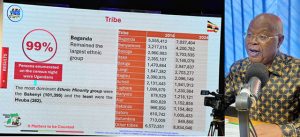Uganda 2024 Census chief apologizes for wrong data on tribes

Dr. Chris Mukiza on The Capital Gang radio show Saturday.
Kampala, Uganda | LOUIS JADWONG | The The Uganda Bureau of Statistics (UBOS) Executive Director and Census Commissioner, Dr. Chris Mukiza has admitted that the information on tribes in the final 2024 Census results he released this week, has significant errors.
“There were no contractions in the number of people across all tribes,” Dr Mukiza said on Capital FM radio’s The Capital Gang on Saturday morning.
The report indicated that Acholi have reduced from 2.1 million to 1.9 million in the 10 years from 2014, while Bagisu are only 2.1 million, down from 2.4million at the last census.
The new official census report had also indicated that Bakiga grew from 1,470,884 in 2014 to 2,947,837 in 2024 – representing a 100.4% increase – while tribes like the Jopadhola who were 481,000 in 2014, were this time listed among ‘others’, with the report not indicating their numbers at all in the entire document.
Unlike the previous census reports by Male Mukasa in 2002 and Paul Mungyereza in 2014, Mukiza’s 2024 report has no appendices. Appendices generally contain tables and figures that are too large to fit into the text of a report, such as the Uganda census report.
“It was a human error. We have clarified this at Capital Gang. The population figures in Census 2014 for Bakiga and Bagisu; Langi and Acholi were erroneously interchanged at the time of printing. Thus, every tribe experienced growth over the past 10 years. Apologies,” he said on X.
It was a human error. We have clarified this at Capital Gang. The population figures in Census 2014 for Bakiga and Bagisu; Langi and Acholi were erroneously interchanged at the time of printing. Thus, every tribe experienced growth over the past 10 years. Apologies
— Dr.Chris Mukiza (@UBOS_ED) October 5, 2024
We might have to circumcise one of those @StatisticsUg bosses just to send a strong message of deterrence. https://t.co/uR5IEssvnq
— Anthony Natif (@TonyNatif) October 4, 2024
The Census report 2024 also indicated that the population of main religions, including Catholics, had declined. The Archbishop of Kampala Paul Ssemogerere has not yet responded to the new figures, but the Catholic church has an elaborate system of tracking their own numbers from Dioceses, to Parish, to sub-parishes and Basic Christian Communities (kabondo).
The official census report was released to much fanfare in Kampala on Thursday. The Prime minister Robinah Nabbanja ‘signed’ the the National Population and Housing Census 2024 main report along side state minister in charge of Planning, Amos Lugoloobi and UBOS board chairman Dr Albert Byamugisha. Other dignitaries in attendance included Oboth Oboth, Minister of Defence and Veteran affairs, together with Hanifah Kawooya Bangirana – State minister health in charge of general duties.
Other than the controversy over the numbers for the tribes and religion, the new Census report is rich in data needed to plan for Uganda’s development.
Here are highlights:
Total Population: Uganda’s total population was 45.9 million people as at May 2024 with 21.6million males and 24.3million females.
The Population growth rate dropped slightly from 3.0 percent in 2014 to 2.9 percent in 2024.
Population distribution: Buganda sub-region had the largest population of 13.0million persons, followed by Busoga (4.4 million persons). Karamoja sub-region had the smallest population of 1.4 million persons.
Population density: Uganda’s Population Density as of 2024 was 224 persons per square kilometer, an increase from 123 people and 173 people per square kilometer in 2002 and 2014 respectively.
Daytime Population in the Cities: This stood at 4.2million persons with the highest share in Kampala Capital City (42.8%) and the least daytime population in Soroti city (3.2%)
PM Nabbanja signs off the report
Saving Mechanisms : Mobile money was the mechanism for saving ( 20 %) followed by keeping cash at home ( 17 %).
Availability of Financial Services : most used VSLAs were the most common, with 75% of the parishes having at least one VSLA. Mobile money services were in 69% of the parishes
Beneficiaries of Government Programs : highest percentage (1 8 S S SAGE AGE has the %) of beneficiaries of a government program.
• Infant mortality: For every 1,000 children born alive, 34 die before they celebrate their 1st birthday.
• Households in Subsistence and Non-Subsistence Economy:Thirty-threepercent of Ugandan households (3.5 million) were in the subsistence economy in 2024 compared to 67percent (7.2million) in the non-subsistence economy.
• Characteristics of Households in Subsistence and Non-SubsistenceEconomy: Among the 3.5 million households in the subsistence economy, 75 percent primarily relied on subsistence agriculture, 10 percent focused mainly on income-generating activities, and 15percent earned wages or salaries.
Religious Affiliations: Catholics and Anglicans constituted half (67%) of the population of Uganda. Catholics constituted37percent of the population
Current marital status: 61percent of women and 51percent of men age 15+ were currently married or living together with their partner as though married
Birth Registration: Long Birth Certificates: 11.4 percent of the population have long birth certificates Birth Notifications: 28 percent of the population had short birth notification records.
No birth certificate and short certificate: 56.8 percent were neither notified nor registered
• Total Fertility Rate:The total fertility rate is 4.5children per woman, which is a decline from 5.8 children in 2014.
• Crude Birth Rate:The crude birth rate was 33.2 births per 1,000 population.
• Adolescent Childbearing:6.5 percent of adolescent girls age 10-19, had begun childbearing.Five percent had a live birth and 1.5 percent were pregnant with the first child.
Mobile phone ownership: In Uganda, 43 percent of individuals aged 10 years and above own a mobile phone, which equates to approximately 13.6 million people. Among these mobile phone owners, 37 percent possess one phone, while six percent own two or more.
Fixed telephone line ownership: Eight percent of households in Uganda have fixed telephone lines.
Ownership of computers and other ICT devices: Seventy-six percent of households had a member who owned a mobile phone, while 41 percent had a radio, 23 percent had a television, and four percent owned a computer.
Computer use: In 2024, only four percent of individuals aged 10 and above used computers, including desktops, laptops, and tablets.
Internet usage: In 2024, nine percent of individuals aged 10 years and above had access to internet facilities. The internet was primarily utilized for social networking (67%), academic work (16%), and business or office tasks (13%).
Sources of information :Thirty-eight percent of households identified the radio as their primary source of information, followed by word of mouth at 22 percent, phone calls at 15 percent, and television at 14 percent.
Online services: In Uganda, about two percent of individuals aged 10 years and above accessed online government services, while about one percent used online shopping, online advertisements, and internet banking respectively.
•Employment to Population Ratio: EPR for Uganda in 2024 was 38percent. The males in employment were higher than females (43%) and (33%) respectively.
•Unemployment Rate: Overall, the unemployment rate was 12.6percent in 2024. Unemployment rate was highest among females (15%) compared to males (11%).
•Youth Unemployment Rate: Sixteen percent (16%) of the population aged 18-30 years were unemployed during 2024.
• Labour Force Participation Rate: Overall, the LFPR was 43% with highest percentage among males (48%) and females (39%).
•Youth Not in Employment, Education or Training (NEET): Education or Training (NEET): Education or Training (NEET Fifty-one percent were neither employed, in education, nor in training, while 35 percent were no longer in school and were employed, and 12 percent were still attending school.
APPENDIX
The post Uganda 2024 Census chief apologizes for wrong data on tribes appeared first on The Independent Uganda:.






